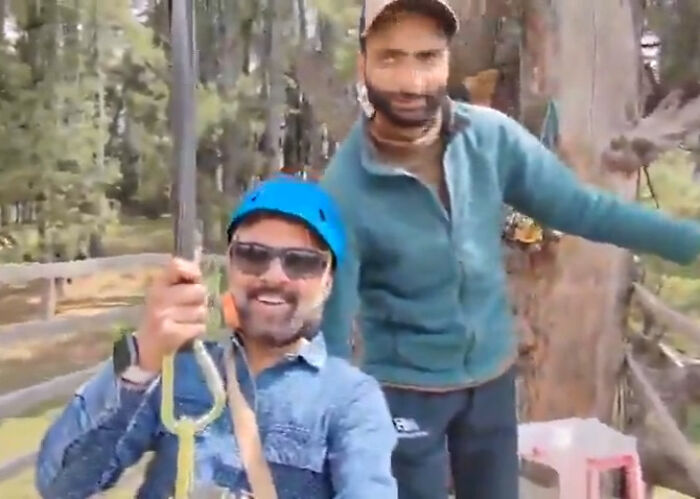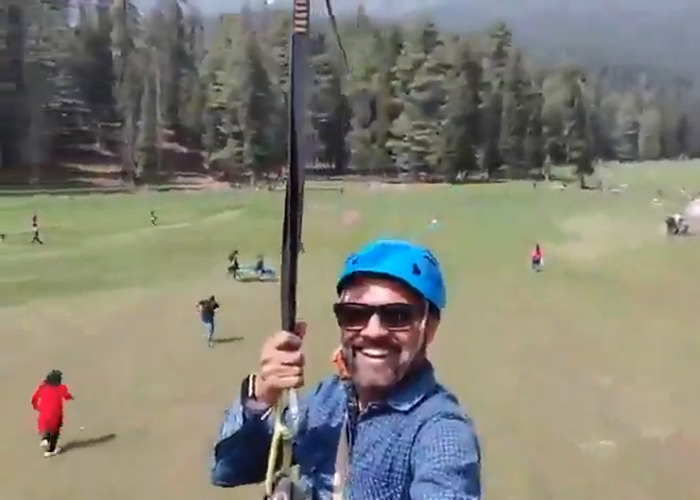
“Oblivious” Tourist Ziplines In Viral Video While Mass Tragedy Occurred Below, Taking 26 Lives
Joy and horror collided in a chilling video that has gripped social media. The clip shows a smiling tourist ziplining over a scenic valley in Kashmir, completely unaware that a horrific attack was unfolding beneath him.
Last Tuesday (April 22), Rishi Bhatt was vacationing in the resort town of Pahalgam when he filmed himself mid-air on a popular zipline attraction in the Baisaran meadow, a popular location frequented by families and children.
- A tourist's recorded himself on a zipline in Kashmir, right before a gunfire attack erupted below him.
- Two attackers were identified as Pakistani nationals, intensifying the India-Pakistan geopolitical crisis.
- The Indian government responded with naval drills, missile tests, and suspended parts of the Indus Waters Treaty.
- Suspension of the treaty threatens millions of Pakistani farmers due to India controlling river headwaters.
Moments into the minute-long clip, Bhatt’s sounds of excitement are abruptly interrupted by loud gunfire as a mass shooting erupted in the valley, resulting in 26 people losing their lives that day.
After reaching the end of the zipline, a stunning realization dawned upon Bhatt, who noticed the shooting had begun near the attraction’s launch point—his decision to jump might’ve saved his life.
A tourist filmed himself ziplining over a scenic valley in Kashmir—right before an armed attack erupted
Image credits: XNews24_7
The viral footage, now widely circulated online, has become a haunting symbol of the chaos that unexpectedly shattered an otherwise tranquil holiday scene—and intensified a long-simmering geopolitical crisis between India and Pakistan.
Two of the three attackers were identified by Indian officials as Pakistani nationals. Authorities also labeled the incident as an act aimed at destabilizing the region.
Witnesses reported that the gunmen specifically targeted Hindu tourists and, in some cases, demanded civilians recite Islamic prayers at gunpoint.
Image credits: XNews24_7
An armed group known as The Resistance Front (TRF) initially claimed responsibility for the attack but later retracted the statement, blaming a “communications breach” for the confusion. The group has been linked to Pakistani-based militant networks by Indian intelligence agencies.
Pakistan also denied any involvement, with officials in Islamabad maintaining that their government supports only the “moral and diplomatic” rights of Kashmiris to self-determination. Nevertheless, the political and military fallout has been severe.
India has enacted several retaliatory measures, the harshest of which could severely affect Pakistani agriculture
Image credits: XNews24_7
Following the attack, the Indian government enacted several retaliatory measures, which included naval drills, test-firing long-range missiles, and the suspension of key provisions of the Indus Waters Treaty—a deal brokered by the World Bank in 1960.
The decision marks the collapse of one of the few functional diplomatic channels between the two nuclear-armed nations. Via the treaty, the rivers of the Indus Basin between India and Pakistan were divided, with India getting the eastern rivers and Pakistan the western ones.
Image credits: Hindustan Times
However, all six rivers originate in Indian-administered territories such as Kashmir, which means India controls the headwaters and thus can physically influence how much water flows downstream into Pakistan.
Image credits: Indranil Aditya/Getty Images
“We fear India can cause flash floods or stop water destined for our crops,” Ali Dogar, a Pakistani farmer, told The Guardian. “India can starve us. Because now India won’t be responsible to share any data about flash floods or dam projects with Pakistan.”
While India currently doesn’t have the infrastructure necessary to completely stop the flow of water, the lack of coordinated water management puts millions of farmers at risk.
Kashmir is of cultural, political, economic, and strategic importance for both nations
Image credits: Debarchan Chatterjee/Getty Images
The roots of the conflict date back to 1947, when India gained independence from British rule.
Kashmir, being at the crossroads of South Asia and surrounded by India, Pakistan, and China, was a princely state with a majority Muslim population, with the option to join either India or Pakistan or remain independent.
Image credits: WION
Its Hindu ruler, Maharaja Hari Singh, initially chose to stay neutral. However, following an invasion by Pakistani tribal forces in October 1947, he requested military assistance from India and, in return, formally joined the country.
Image credits: ANI News
This sparked the first Indo-Pakistani War and the subsequent establishment of a Line of Control after a United Nations-backed ceasefire. As a result, Kashmir lies divided to this day between areas occupied by Pakistan, India, and China.
🚨HEARTBREAKING: Unseen footage of the #PahalgamTerroristAttack surfaces! A man from Ahmedabad unknowingly captured the horrific moment when terrorists struck Baisaran Valley, killing 26 tourists. Gunshots and screams echo in the chilling video. Share to demand justice!… pic.twitter.com/ow6VdRtuG3
— NewsDaily🪖🚨🪖 (@XNews24_7) April 28, 2025
While the conflict rages, families mourn the victims, and Kashmir’s streets fall quiet to a security clampdown. With Pakistan authorities referencing their nuclear armament in statements, it remains to be seen whether this attack escalates into a broader conflict or diplomacy is able to prevail.
“Spine-chilling.” Netizens are watching the conflict unfold with bated breath
Image credits: LancasterD8064
Image credits: justanazmomma
Image credits: Bruidbtc
Image credits: nomad_grj
Image credits: Deepesh26062690
Image credits: Shitpost_44
Image credits: simplykalakaar
Image credits: CottonsRevenge
Image credits: kenup
Image credits: WintonDupree
Image credits: saltnsasstx2fla
Image credits: abdullahadam
Image credits: Charlie43211234
Image credits: 9Unknownmen
Image credits: Mariefrom1961
Image credits: smythe_13526
Image credits: satviks78
Image credits: BHAVESH_Q
Image credits: Reshi1974
Poll Question
Thanks! Check out the results:
To be fair, if I were ziplining, I'd be so scared, all my focus would be about hanging on and looking brave for my photo. There could be a raging forest fire beneath me and I probably would not notice. I very much doubt he would deliberately and knowingly zipline through a virtual war zone where shots were being fired. Ridiculous to suggest he knew what was going on.
Agreed. Zip-lining is an adrenaline-inducing activity -- and during such activities, people's senses are affected.
Load More Replies...Most people have never heard gunfire, and if you're unfamiliar with the sound it's like A car backfiring or a small 4th of July fireworks. This is why there's always a few moments before you realize you're in a school shooter scenario. And sound carries very strangely in a mountain environment, you can be directly over something and not hear it.
To be fair, if I were ziplining, I'd be so scared, all my focus would be about hanging on and looking brave for my photo. There could be a raging forest fire beneath me and I probably would not notice. I very much doubt he would deliberately and knowingly zipline through a virtual war zone where shots were being fired. Ridiculous to suggest he knew what was going on.
Agreed. Zip-lining is an adrenaline-inducing activity -- and during such activities, people's senses are affected.
Load More Replies...Most people have never heard gunfire, and if you're unfamiliar with the sound it's like A car backfiring or a small 4th of July fireworks. This is why there's always a few moments before you realize you're in a school shooter scenario. And sound carries very strangely in a mountain environment, you can be directly over something and not hear it.

 Dark Mode
Dark Mode 

 No fees, cancel anytime
No fees, cancel anytime 









































































29
17